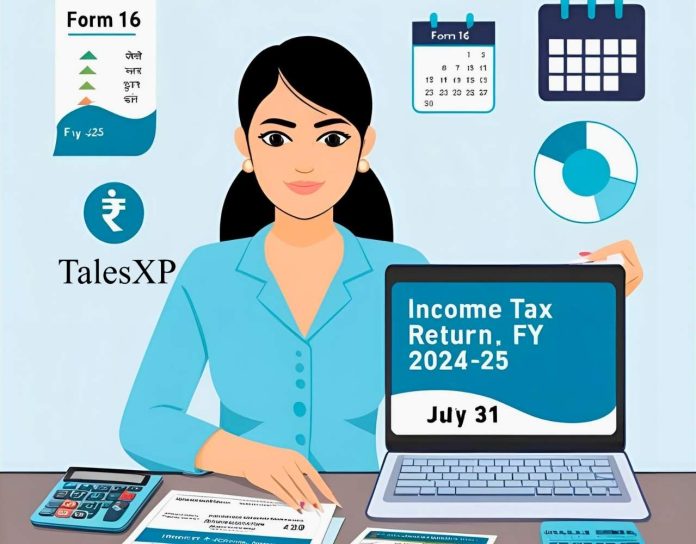As India enters the income tax filing season for the Financial Year (FY) 2024–25 and Assessment Year (AY) 2025–26, taxpayers are actively seeking answers to key questions. From choosing the correct ITR form to understanding tax regimes and knowing deadlines, the list of concerns is extensive.
This article compiles the 25 most common queries related to income tax filing in India and provides in-depth, up-to-date answers in simple language. Whether you are a salaried employee, freelancer, or business owner, this guide is designed to help you file accurately and confidently.
Let’s break down every important aspect of tax filing in FY 2024–25.
1. What is the last date to file income tax return for FY 2024–25?
The due date for filing ITR for individuals (not subject to audit) is July 31, 2025.
Important: For taxpayers requiring audit, the deadline is October 31, 2025. If you miss the deadline, you can file a belated return until December 31, 2025 with a late fee under Section 234F.
2. Which ITR form should I use for FY 2024–25?
| ITR Form | Applicable To | Conditions |
|---|---|---|
| ITR-1 (Sahaj) | Salaried individuals, pensioners | Income up to ₹50 lakh, only one house property |
| ITR-2 | Individuals/HUFs | No business income |
| ITR-3 | Individuals/HUFs | Business or professional income |
| ITR-4 (Sugam) | Presumptive scheme users | Income up to ₹50 lakh under presumptive taxation |
3. What are the income tax slab rates for FY 2024–25?
New Tax Regime (Default from FY 2023–24):
| Income Slab | Tax Rate |
|---|---|
| ₹0–3,00,000 | 0% |
| ₹3,00,001–6,00,000 | 5% |
| ₹6,00,001–9,00,000 | 10% |
| ₹9,00,001–12,00,000 | 15% |
| ₹12,00,001–15,00,000 | 20% |
| Above ₹15,00,000 | 30% |
Note: Standard deduction of ₹50,000 is available in the new regime as well.
4. What is the difference between the old and new tax regimes?
| Criteria | Old Regime | New Regime |
|---|---|---|
| Tax Slabs | Higher | Lower |
| Deductions | Many available | Very limited |
| Default? | No | Yes |
| Form Needed? | Form 10-IEA (to switch) | Not required if opting new |
Tip: Choose old regime if you have large deductions. New regime suits low or no deductions.
5. Can I switch between tax regimes every year?
Yes, salaried individuals can switch between old and new regimes annually. Business owners can switch only once.
6. What deductions are allowed under the new regime?
- Standard Deduction of ₹50,000
- Employer’s NPS contribution (80CCD(2))
- Agniveer Corpus Fund (80CCH)
7. What documents are required for ITR filing?
- PAN, Aadhaar
- Form 16, salary slips
- Form 26AS, AIS
- Investment proofs, rent receipts
8. Can I file ITR for past years?
No, you can’t file for years earlier than FY 2023–24 unless you apply for condonation from the Income Tax Department for a valid reason.
9. How to claim refund of excess tax paid?
- File your return with correct details.
- E-verify the return.
- Refund will be credited to your bank account linked with PAN.
10. How is income from stocks or mutual funds taxed?
| Asset | Holding Period | Short-Term Tax | Long-Term Tax |
|---|---|---|---|
| Stocks | <12 months | 15% | 10% over ₹1 lakh |
| Mutual Funds (Equity) | <12 months | 15% | 10% |
| Mutual Funds (Debt) | <36 months | Slab Rate | 20% with indexation |
11. What is AIS (Annual Information Statement)?
AIS is a comprehensive financial statement that includes:
- Bank interest
- Dividend income
- Stock transactions
- High-value transactions
Check your AIS via the income tax portal to ensure transparency.
12. What is Form 26AS and why is it important?
Form 26AS is a tax credit statement. It shows:
- TDS deducted
- Advance tax paid
- Refunds received
Always check Form 26AS before filing to avoid mismatch errors.
13. What if I made a mistake in my filed ITR?
You can revise your return using Section 139(5) before December 31, 2025.
14. Can I file ITR without Form 16?
Yes. Use:
- Salary slips
- Form 26AS
- AIS (Annual Information Statement)
- Bank statements
Calculate your income, subtract eligible deductions, and file accordingly.
15. Is it mandatory to file ITR if income is below ₹2.5 lakh?
No, it is not mandatory.
However, you must file if:
- TDS has been deducted and you want a refund.
- You hold foreign assets.
- You want to carry forward losses.
- You’re applying for visa, loans, or tenders.
16. How do I file my ITR online for FY 2024–25?
Steps:
- Visit www.incometax.gov.in
- Log in using PAN and password.
- Choose “File Income Tax Return.”
- Select the assessment year (2025–26) and ITR form.
- Fill in details, verify, and submit.
- E-verify using Aadhaar OTP or net banking.
17. What documents are required for ITR filing in India?
You don’t need to upload these while filing, but you must keep:
- PAN Card
- Aadhaar Card
- Form 16 from employer
- Salary Slips
- Bank Statements
- Interest Certificates (FD, RD, savings)
- Investment Proofs (ELSS, LIC, PF, etc.)
- Rent receipts for HRA
- Form 26AS and AIS
18. What deductions are allowed under the new regime in FY 2024–25?
The new regime allows very few deductions:
- Standard Deduction of ₹50,000
- Employer’s contribution to NPS under Section 80CCD(2)
- Agniveer Corpus Fund contributions under Section 80CCH
Most popular deductions like 80C, 80D, 80E, HRA, and LTA are not available.
19. Can I switch between tax regimes every year?
Yes, but with a condition:
- If you have only salary income, you can choose either regime each year while filing.
- If you have business income, you can opt out of the new regime only once.
Use Form 10IEA to notify your preference for the old regime.
Filing your income tax return correctly and on time is not just a legal necessity, but also a smart move financially. The queries listed above cover nearly every aspect of income tax filing for FY 2024–25.
FAQs
Q: Can I file ITR after July 31, 2025?
A: Yes, but late fees apply until December 31, 2025.
Q: Will I get a refund if I file late?
A: Yes, if eligible. But interest earned on refund may be lower.
Q: Is Aadhaar mandatory for filing ITR?
A: Yes, PAN-Aadhaar linking is mandatory for filing returns.































